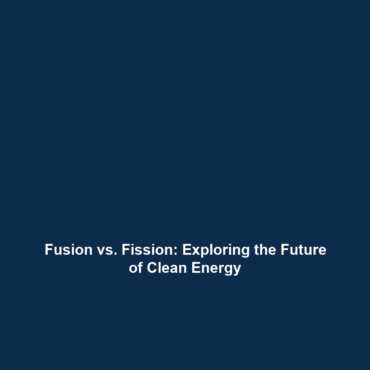Fusion vs. Fission: Understanding the Energy Landscape
Introduction
Fusion and fission are two critical processes in the field of nuclear energy, each representing unique methods of harnessing energy. Unlike nuclear fission, which splits atoms, fusion combines them, resulting in more energy and fewer radioactive byproducts. This article explores these processes, elucidating their significance within the broader context of fusion energy. As the world seeks sustainable energy solutions, understanding the distinctions between fusion and fission becomes increasingly vital. This basic understanding not only enhances public awareness but also fuels current scientific inquiry into fusion energy as a cleaner energy source.
Key Concepts
What is Fission?
Nuclear fission is the process of splitting heavy atomic nuclei into smaller, lighter nuclei, accompanied by the release of a significant amount of energy. This process is the foundation of nuclear reactors worldwide, which convert this energy into electricity.
What is Fusion?
Conversely, nuclear fusion involves the merging of lightweight atomic nuclei to form a heavier nucleus. It powers the stars, including our sun, and has the potential to generate vast amounts of energy in a sustainable manner. The fusion process tends to produce fewer radioactive byproducts compared to fission, making it a cleaner alternative.
Significance in Fusion Energy
Both processes play integral roles in the future of fusion energy. While fission technologies have been harnessed for various energy needs, the pursuit of controlled fusion offers a promising frontier for tackling energy shortages while minimizing environmental impacts.
Applications and Real-World Uses
Understanding how fusion and fission are used in practical applications is key to realizing their potential benefits:
- Fission Applications: Used in nuclear power plants to generate electricity for millions of homes globally.
- Fusion Applications: Research is underway to develop fusion reactors that can provide a near-limitless energy source with minimal environmental impact.
Applications of fusion energy could revolutionize energy generation, making it a pivotal element in sustainable development initiatives worldwide.
Current Challenges
Despite the potential advantages, there are significant challenges in studying and implementing fusion energy:
- Technical hurdles in achieving and maintaining the high temperatures and pressures needed for fusion.
- Economic viability of fusion technology in comparison to established fission reactors.
- Long research timelines required to develop practical fusion solutions.
These challenges highlight the complexities surrounding the pursuit of fusion energy and the ongoing need for continued investment and innovation.
Future Research and Innovations
The future of fusion energy is promising, with several breakthroughs on the horizon:
- Development of tokamaks and stellarators aimed at sustaining controlled fusion reactions.
- Advancements in superconducting magnets that could reduce energy input and enhance reaction efficiency.
- Innovations in inertial confinement fusion techniques that may lead to more compact energy systems.
These innovations are poised to significantly impact the efficiency and feasibility of fusion energy production, advancing us towards a cleaner energy future.
Conclusion
In summary, fusion versus fission presents a compelling comparison in the realm of nuclear energy. Unlike nuclear fission, which splits atoms, fusion combines them, resulting in more energy and fewer radioactive byproducts—a crucial advantage in tackling the world’s energy challenges. As research progresses, the relevance of controlled fusion energy becomes increasingly apparent. For further information on advancements in nuclear energy technologies, consider exploring our articles on nuclear fission and green energy solutions.

Leave a Reply